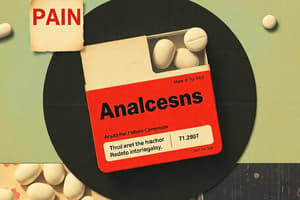Podcast
Questions and Answers
Which of the following is a common side effect of aspirin at analgesic doses?
Which of the following is a common side effect of aspirin at analgesic doses?
- Increased blood sugar (correct)
- Decreased blood sugar
- Increased blood pressure
- Decreased blood pressure
What is the main mechanism of action of aspirin as an analgesic?
What is the main mechanism of action of aspirin as an analgesic?
- Activation of opioid receptors
- Inhibition of COX
- Reduction of prostaglandin levels (correct)
- Blockage of nerve impulses
Which of the following is a potential side effect of long-term aspirin use?
Which of the following is a potential side effect of long-term aspirin use?
- Increased risk of infection
- Decreased risk of infection
- Increased risk of bleeding (correct)
- Decreased risk of bleeding
Which of the following is a characteristic of Reye's syndrome?
Which of the following is a characteristic of Reye's syndrome?
Which enzyme is inhibited by NSAIDs to relieve pain due to inflammation?
Which enzyme is inhibited by NSAIDs to relieve pain due to inflammation?
Which of the following is a non-selective COX inhibitor?
Which of the following is a non-selective COX inhibitor?
Which type of NSAID is most frequently used for mild-to-moderate pain?
Which type of NSAID is most frequently used for mild-to-moderate pain?
Which of the following is a shared toxicity due to prostaglandin synthesis inhibition by NSAIDs?
Which of the following is a shared toxicity due to prostaglandin synthesis inhibition by NSAIDs?
Which drug is an alternative to aspirin and is better tolerated orally with low incidences of adverse reactions?
Which drug is an alternative to aspirin and is better tolerated orally with low incidences of adverse reactions?
Which drug is contraindicated in pregnant women and peptic ulcer patients?
Which drug is contraindicated in pregnant women and peptic ulcer patients?
Which drug is highly bound to plasma proteins and should never be used with anticoagulants?
Which drug is highly bound to plasma proteins and should never be used with anticoagulants?
Which drug is commonly used in dentistry to suppress swelling and inflammation after tooth extraction?
Which drug is commonly used in dentistry to suppress swelling and inflammation after tooth extraction?
Which of the following is a common side effect of using NSAIDs?
Which of the following is a common side effect of using NSAIDs?
What is the mechanism of action of NSAIDs?
What is the mechanism of action of NSAIDs?
Which NSAID can be used for parenteral administration?
Which NSAID can be used for parenteral administration?
Which NSAID is a weak inhibitor of prostaglandin synthesis and exerts anti-inflammatory action through other mechanisms?
Which NSAID is a weak inhibitor of prostaglandin synthesis and exerts anti-inflammatory action through other mechanisms?
Which of the following is a potential side effect of long-term NSAID use for periodontal benefits?
Which of the following is a potential side effect of long-term NSAID use for periodontal benefits?
Which type of NSAID inhibits osteoclastic activity in periodontitis?
Which type of NSAID inhibits osteoclastic activity in periodontitis?
What happens to the periodontal benefits of long-term NSAID use when patients stop taking the drugs?
What happens to the periodontal benefits of long-term NSAID use when patients stop taking the drugs?
Which of the following drugs is a newer congener of piroxicam and has a COX2:COX1 selectivity ratio of 10?
Which of the following drugs is a newer congener of piroxicam and has a COX2:COX1 selectivity ratio of 10?
Which drug should be avoided in the presence of severe hepatic/renal disease and in those receiving rifampin, warfarin, and methotrexate?
Which drug should be avoided in the presence of severe hepatic/renal disease and in those receiving rifampin, warfarin, and methotrexate?
Which drug is a central analgesic and antipyretic, but a poor inhibitor of PG synthesis in peripheral tissues?
Which drug is a central analgesic and antipyretic, but a poor inhibitor of PG synthesis in peripheral tissues?
Which drug is a good and promptly acting antipyretic, and does not affect platelet function or clotting factors?
Which drug is a good and promptly acting antipyretic, and does not affect platelet function or clotting factors?
Which endogenous agents are involved in the complex mechanism of action of NSAIDs in relation to periodontitis?
Which endogenous agents are involved in the complex mechanism of action of NSAIDs in relation to periodontitis?
Which properties do NSAIDs possess?
Which properties do NSAIDs possess?
What was the main mechanism of action of NSAIDs discovered by John Vane and co-workers in 1971?
What was the main mechanism of action of NSAIDs discovered by John Vane and co-workers in 1971?
Flashcards are hidden until you start studying




